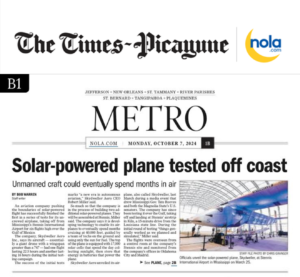A huge solar-powered plane is being tested off the Mississippi coast. It could spend months in the air.
The company behind the airplane says first batch of tests showed their technology will work.
BY BOB WARREN | Staff writer
An aviation company pushing the boundaries of solar-powered flight has successfully finished the first in a series of tests for its uncrewed airplane, taking off from Mississippi’s Stennis International Airport for six flights high over the Gulf of Mexico.
The company, Skydweller Aero Inc., says its aircraft — essentially a giant drone with a wingspan greater than a 747 — had one flight lasting 22.5 hours and another lasting 16 hours during the initial testing campaign.
The success of the initial tests marks “a new era in autonomous aviation,” Skydweller Aero CEO Robert Miller said.
So much so that the company is in the process of building two additional solar-powered planes. They will be assembled at Stennis, Miller said.
The company says it is developing technology to enable its airplanes to eventually spend months cruising at 40,000 feet, guided by a team of techs on the ground and using only the sun for fuel. The top of the plane is equipped with 17,000 solar cells that spend the day collecting sunlight, then store that energy in batteries that power the plane.
Skydweller Aero unveiled its airplane, also called Skydweller, last March during a media event that drew Mississippi Gov. Tate Reeves and both the Magnolia State’s U.S. senators. The company has since been testing it over the Gulf, taking off and landing at Stennis’ airstrip in Kiln, a 15-minute drive from the Louisiana state line.
During the initial round of testing “things generally worked as we planned and simulated,” Miller said.
The flights were overseen from a control room at the company’s Stennis site and monitored from the company’s offices in Oklahoma City and Madrid.
What’s next?
Next up is to “integrate payloads,” that is the surveillance equipment the aircraft will use on its missions over the Gulf or Caribbean Sea, Aero CEO Robert Miller said this week.
Miller said the early test flights have been a success and mark a huge step forward for the company.
“We are excited to continue pushing the boundaries of what uncrewed solar-powered aircraft can achieve,” Miller said.
The testing is being performed in a partnership of sorts with the U.S. military. The Navy had awarded the company a $5 million development contract in 2021, and Miller said more military contracts are in the works “for significantly more than that.”
At the time its airplane was publicly unveiled last spring, the company and state officials said Skydweller Aero’s work would continue a rich tradition of aviation innovation along the coast, noting the proximity of the company’s operations to NASA’s John C. Stennis Space Center nearby.
Reeves and the other elected officials also touted the company as a potential jobs producer.
And that might already be coming to fruition.
Miller said one new airplane is expected to be complete by the end of next year and the other sometime in 2026. And the company says it expects the full-time workforce to grow from 15 now to 65-75 in the next couple of years.
The assembly is painstaking and precise.
“You don’t just put a 236-foot wingspan aircraft together in your garage,” he said with a chuckle.
The original article, including photos exclusive to the Times-Picayune, can be accessed here: Solar-powered plane off Gulf Coast could spend months in air | Business News | nola.com]
